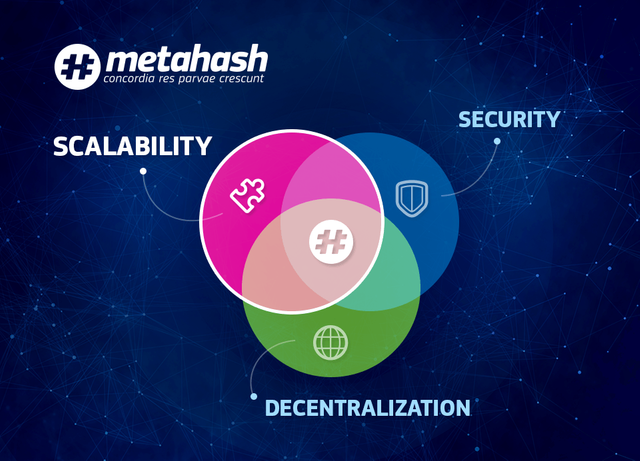Blockchain trilemma solution. Scalability

Since 2018, the market saw a large number of infrastructure projects that have accelerated the practical development of the blockchain ecosystem. But each of them faced the seeming impossibility to put into practice a simultaneous combination of the three most important blockchain indicators: security, scalability and decentralization. The creators of #MetaHash managed to find the right balance. But first things first.
Speaking of scalability, in order to achieve it, several subtasks need to be solved: how to ensure high transaction speed, to enable the storage of network data, and to resolve the issue of synchronization. All these factors are very closely interconnected.
An insufficiently fast blockchain is usually caused by poor synchronization — in most modern networks, the blocks synchronization by all nodes takes approximately 20 seconds. Another factor slowing down the blockchain is waiting till the transaction is completed. Even if it is possible to reduce the block formation time to 1 or 0.5 seconds, there is still a certain number of confirmations that must be passed before the transaction is fully accepted. As a result, it significantly reduces the synchronization speed — up to 6–7 seconds. But cross-continental data transmission stays the main problem of synchronization. Let’s imagine that there are only two nodes in the network, with a maximum Internet channel speed of 10 gbit — one of the nodes located in Europe, and the second one in Asia. While establishing a connection and synchronizing the blocks between them, the effective speed is reduced to 1 gbit. That is why most PoS blockchains limiting the number of nodes face a bottleneck of 2000–4000 transactions per second. Don’t forget that consensus supported by a large number of nodes is expensive, but if many transactions go through the network, the cost of each will be acceptable for each user. The next most important factor of fast blockchain is data storage. Our developers calculated that if a network transmits up to 50 thousand transactions per second, it generates 385 terabytes of data. And, of course, all this information needs to be stored somewhere and managed at the same time, even with minimal network bandwidth.
In #MetaHash the issue of synchronization and transaction confirmation was resolved thanks to validators adding, and therefore, so many confirmations are no longer required. In addition, it is possible to configure a certain number of signatures on the block synchronization way. It’s needed to ensure transaction confirmation in the manner that the final user does not have to wait for the next block. Thus, a network participant will be able to receive more verified transactions from the network at one time, which, of course, speeds up the process. The problem of the geophysical location of nodes disappeared when we significantly increased the number of micro-connections to temporary clusters in order to distribute all the data of single transactions. To do this, it was not necessary to synchronize the transactions themselves between all continents — only their ID and block signatures. Data storage is carried out in the Noda archive, where a Genesis block is generated after every billion transactions. So, each new node can check the entire history of the blockchain without having to store it all, just receiving the information from the current Genesis block.
In the following articles we will talk about security and decentralization of the blockchain network, so, stay with us!
— — — — — — — — — — — — — — — — — — — — — — — — — —
We are expanding the pool of partners: now exchanges could list our token themselves. Here is a link to the guide — https://metahash.org/for_exchanges
Our website: https://metahash.org
Telegram: https://t.me/metahash_ENG
Twitter: https://twitter.com/themetahash
Warning! This user is on our black list, likely as a known plagiarist, spammer or ID thief. Please be cautious with this post!
If you believe this is an error, please chat with us in the #appeals channel in our discord.